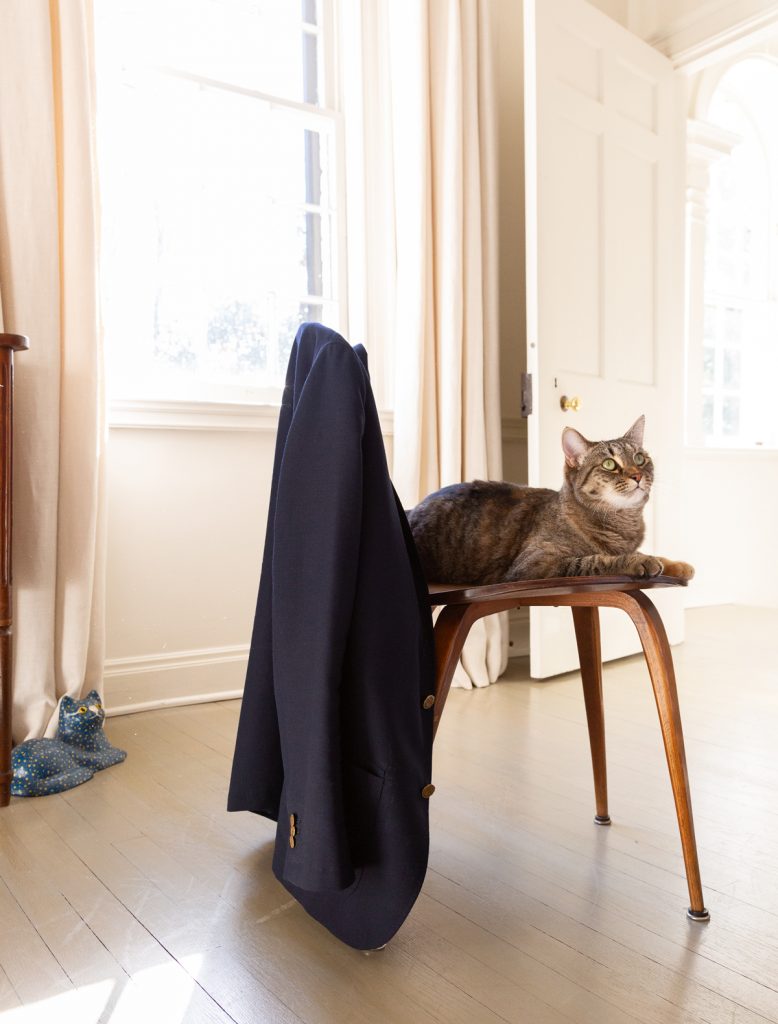
George Frazier’s “The Art of Wearing Clothes” is one of the best essays about classic men’s style. Originally published in a September 1960 issue of Esquire, it came right before the 1970s dress revolution when tailored clothing began its slow slide into irrelevancy. In his essay, Frazier singled out A. J. Drexel Biddle as the best-dressed man in the United States. By modern standards, Biddle’s wardrobe was monastic. It consisted of just seven so-called business suits, supplemented with a smattering of formalwear and outerwear. The lesson is that you don’t need much to be well dressed, just a skeletal wardrobe of beautifully tailored suits and maybe a black tie rig.
Since that essay was published, the world has changed, and the social space in which men can wear suits has dramatically shrunk. For most people, suits are formal attire that you wear to weddings, funerals, and court appearances. The only people who wear suits daily anymore are people who sell them. Yet, nothing flatters a person more. Unlike casualwear, suits are built up from layers of haircloth, canvassing, and padding, which allows a tailor to give you Vitruvian proportions if you don’t naturally have them.
So then, what’s the solution? If you struggle to wear suits in daily life, consider sport coats. Sport coats don’t lend themselves to the monasticism of Biddle’s wardrobe — after all, you need a separate wardrobe of various trousers. But they give you the same benefits of a suit jacket without making you look like you’re headed to a board meeting. They can be dressed up with a tie and tailored trousers, or worn more casually with chinos or jeans. They work just as well for the office or on weekends. And in softer cuts, they can look relaxed and semi-casual.
In this two-part series, we’ll cover how to build a sport coat wardrobe. It will include the basics and not-so-basics, go over fabric options, and discuss color. In the first part of our series, we’ll discuss how to build a sport coat wardrobe for spring and summer. Come back later this year for our fall and winter edition.
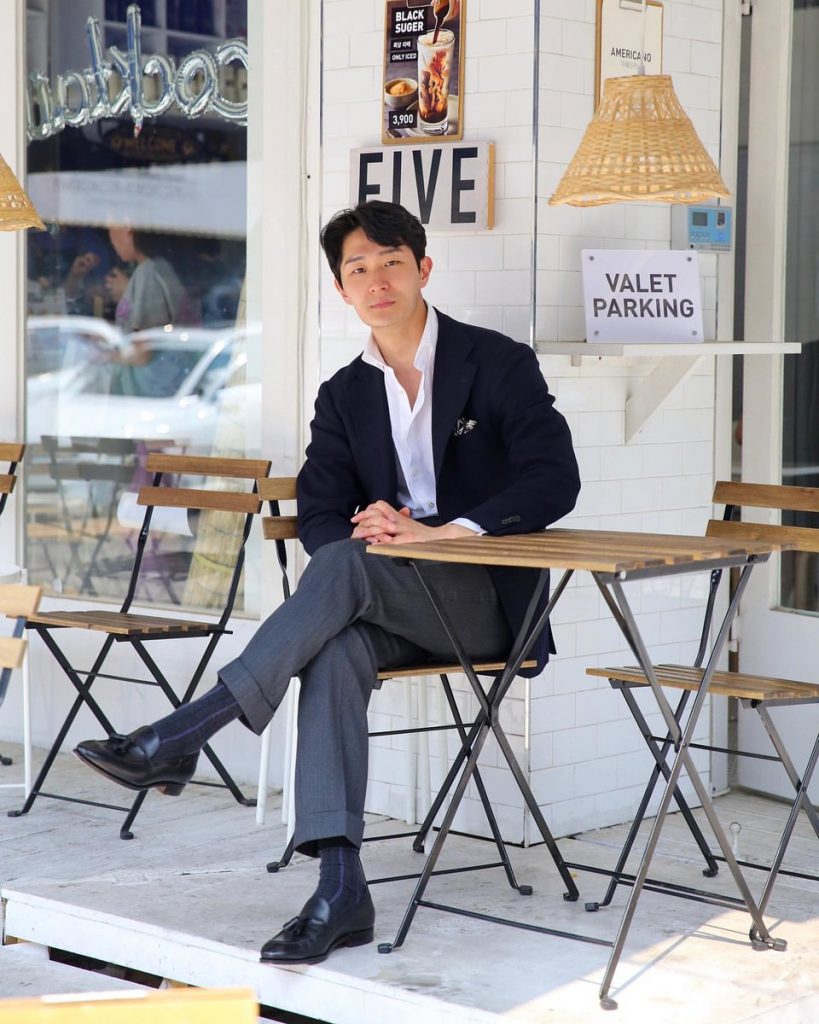
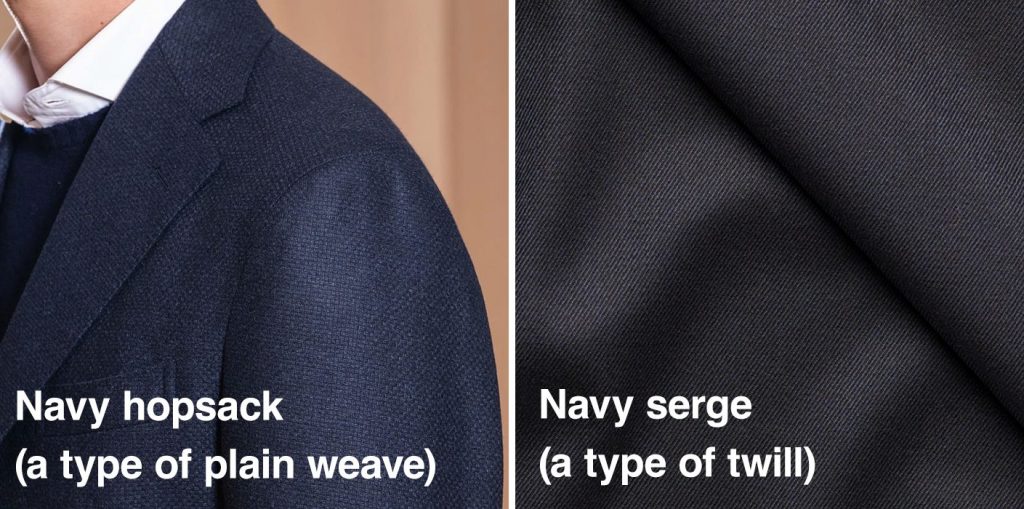
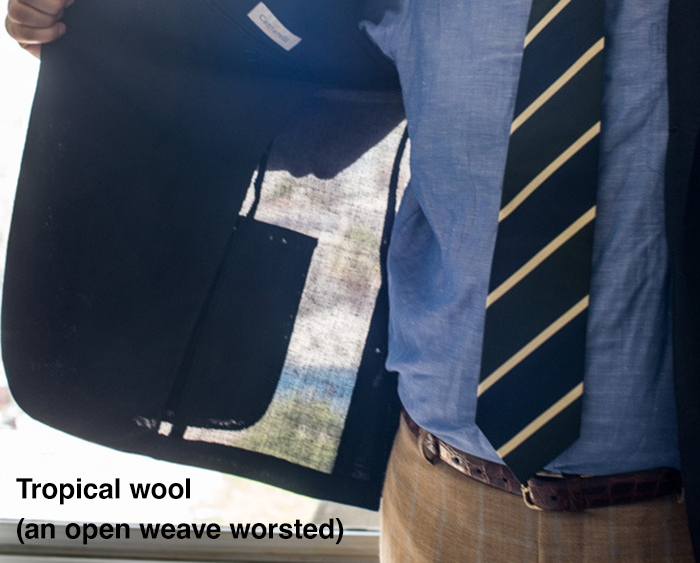
The Essential Sport Coat: Solid Navy
I’m reluctant to call anything a menswear essential nowadays because people have different needs and lifestyles. But if you only own one sport coat, make it solid navy. A navy sport coat is like the tofu of tailoring. It’s simple, bland, and not terribly interesting on its own, but it can also soak up the flavors around it, making it a useful ingredient in any outfit/ dish. A navy sport coat can be made to look professional if you team it with a white dress shirt, rep tie, wool trousers, and derbies. At the same time, it can look casual with a long-sleeved polo or oxford button-down, jeans or chinos, and suede chukkas or loafers. A navy sport coat is the sort of thing that you can wear multiple times a week with few people noticing, and it’s the sort of grab-and-go jacket that doesn’t require much coordination.
Most men should start with a navy sport coat that they can wear for most of the year. That means getting something in a midweight cloth somewhere between 12 to 14 oz, which will be comfortable on all but the hottest and coldest of days. Hopsack, serge, and doeskin are among the most common fabric options since they have a bit of texture, helping to distinguish your sport coat from finer suit jackets (which, of course, should never be worn on their own).
If you live in an area with real summers, you will also need a sport coat that can deal with the heat. Get something made from tropical wool, an airy, open weave fabric made from high-twist yarns. The open weave allows heat to easily escape, while the high-twist yarns give the material a natural level of wrinkle resistance (making these jackets also good for travel). You can tell if a fabric is breathable by holding it up to the light. If you see the light pouring through, it will wear cooler than something densely woven. Lastly, if breathability is a strong concern, make sure your navy sport coat is softly tailored. A lightweight sport coat made with a single layer of canvas inside will be more breathable than one made from multiple layers of haircloth, canvas, felt, and other materials.
Photos: Sanghoon Jang, Cavour, Fox Brothers, and Jesse Thorn
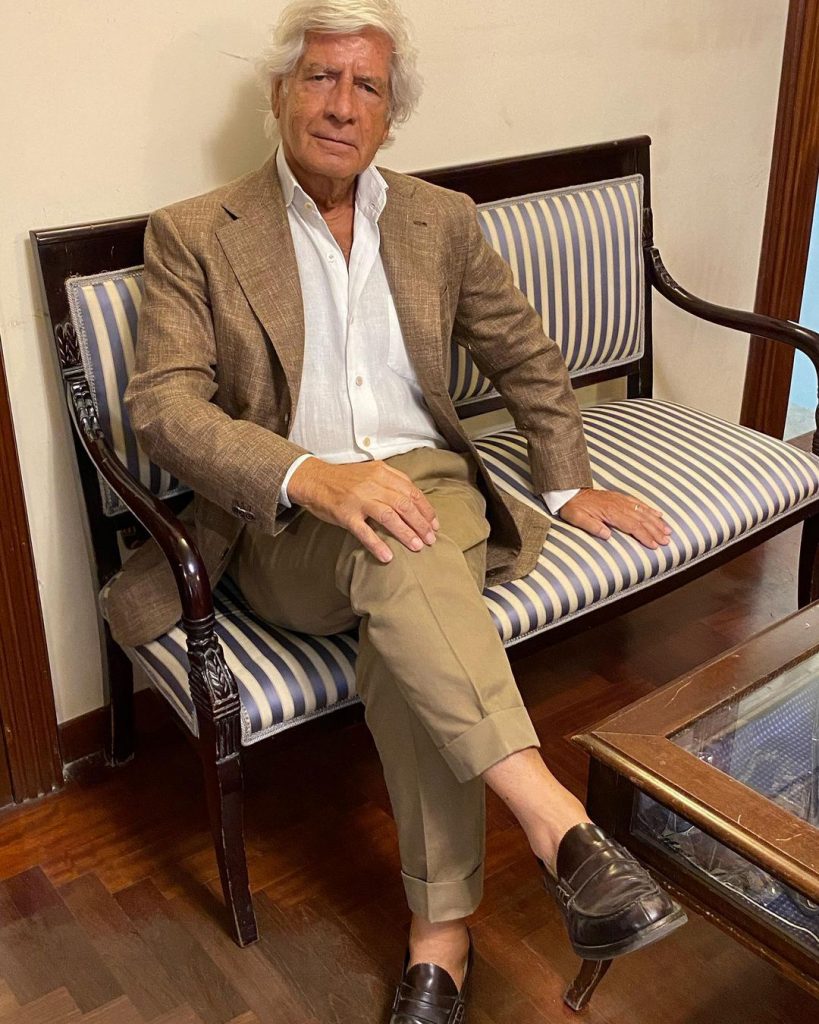
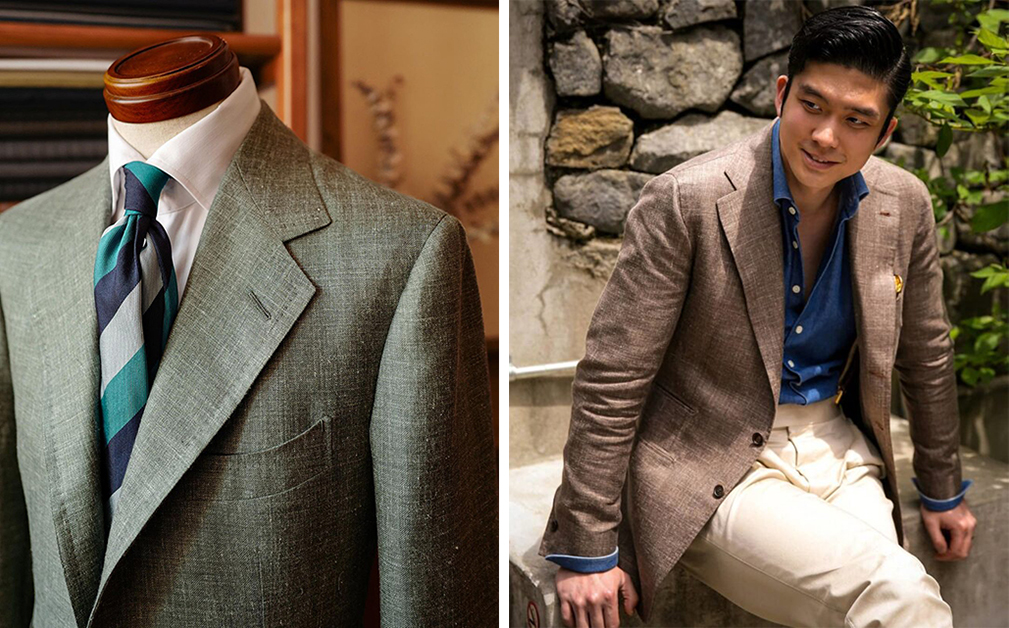
Second Summer Sport Coat: Wool-Silk-Linen
One of the problems with summer jacketings is the nature of worsted cloth itself. Fabric comes in two types: worsted and woolen. Maybe these categories should be renamed to combed and uncombed, however, because it’s the combing process that distinguishes them.
Combing wool is exactly what it sounds like. Before spinning yarn, a maker will comb out the fleece to set the hairs parallel to each other and remove any shorter fibers that would spoil the regularity characteristic of worsted. After the wool has been combed, it’s spun into yarn and then woven into a fabric. And by combing the hairs first, the resulting material will feel a bit smoother and crisper. On the other hand, woolens aren’t put through this preparation process. Thus, the fabric is spongier and loftier, as the wool fibers point in every possible direction. To give examples, wool gabardine is worsted, while tweed is typically woolen.
Summer fabrics are typically worsted because they don’t have the fuzzy nap that would otherwise trap heat. Worsted yarns can also be used to make lighter-weight materials, helpful for summer. The downside? Worsted patterns tend to be sharper and crisper, sometimes making them not very appealing. When you have a fuzzy fabric, you can hide the sharpness of the lines, sort of like how chalkstripe (typically a woolen) looks softer and more approachable than pinstripe (typically a worsted). This is why a lot of summer tailoring is more often about big, blocky colors, as sharply defined patterns can look dizzying in the muggy heat.
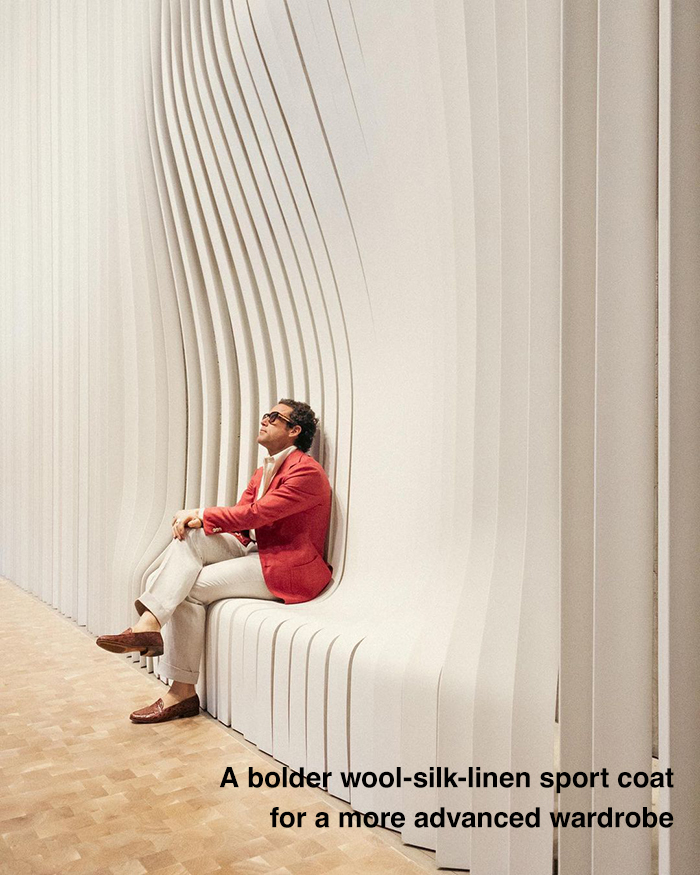
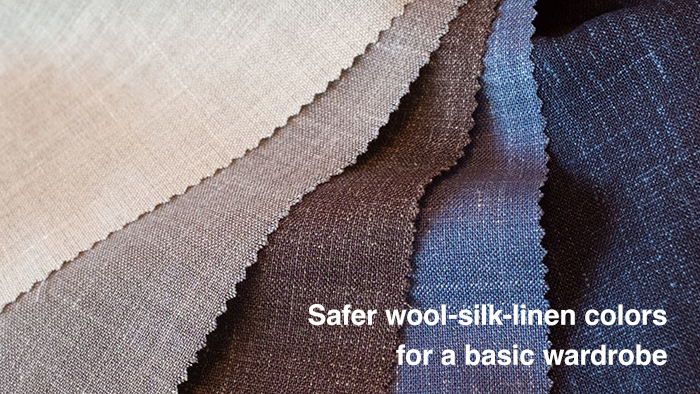
Yet, patterned sport coats can be useful because they add visual interest to simple outfits, especially if you mostly wear solid-colored shirts without a tie. So for your second or third summer sport coat, consider wool-silk-linen (WSL). WSL combines the best of all three fibers: the drape of wool, the luster of silk, and the crisp, dry handle of linen. When spun into yarn, these fibers are more than the sum of their parts. WSL fabrics tend to be airy and breathable, making them ideal for the dog days of summer. They straddle the line between formal and casual, so you can wear them to work and on weekends. Best of all, WSL fabrics typically have a unique texture and mottling — hatches and flecks of dark yarns mixed with lighter ones. Their distinctive appearance allows them to add visual interest to simple, solid-colored outfits. At the same time, they’re not so busy as to clash with patterns. Think of them as flecked Donegals for summer — sort of patterned, but also solid colored.
WSL sport coats tend to have an Italian sensibility, although British mills and fabric merchants also offer the cloth. They’re safest in neutral colors such as blue, brown, or sage. In a much larger wardrobe, you can go for bolder colors such as vermillion. However, bolder sport coats are harder to wear multiple times a week without people thinking, “here comes that guy in the crazy sport coat.” In a neutral tone, this gives you the grab-and-go versatility of a navy sport coat, just in a different color.
Photos: Sartoria Solito, Last & Lapel, Peter Zottolo, and Alan Flusser
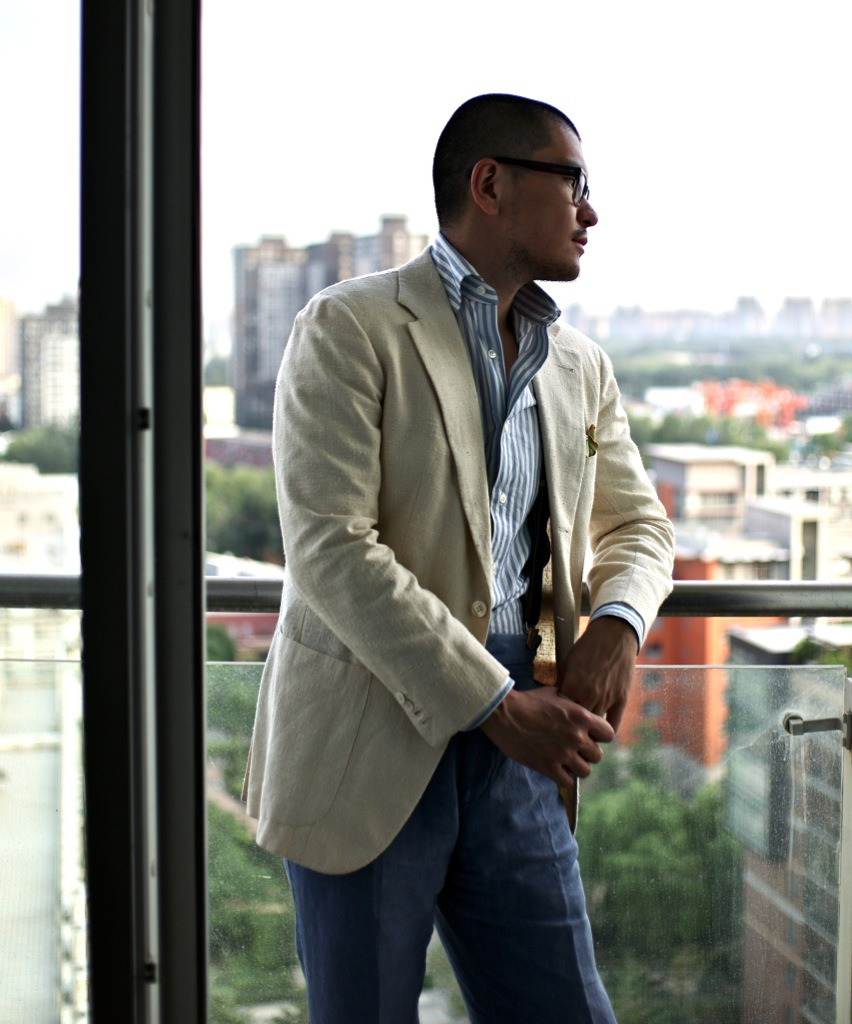
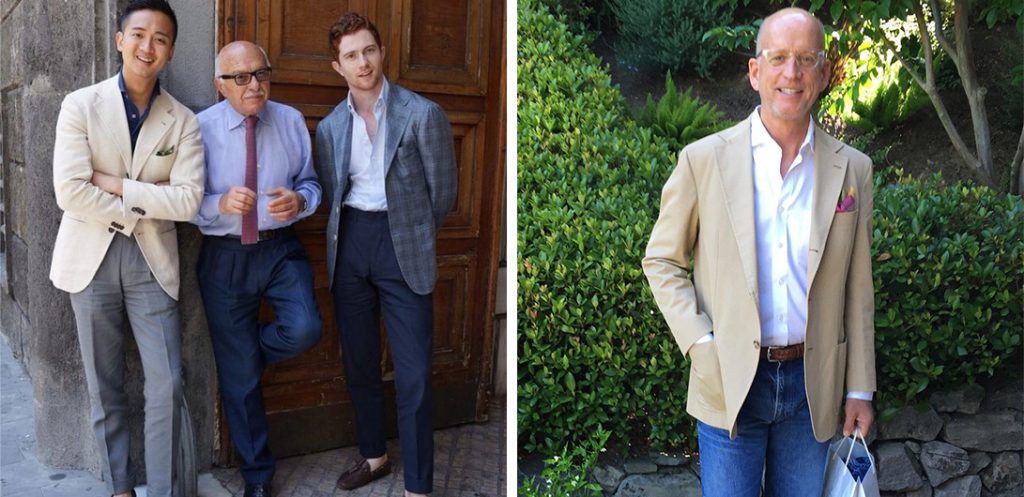
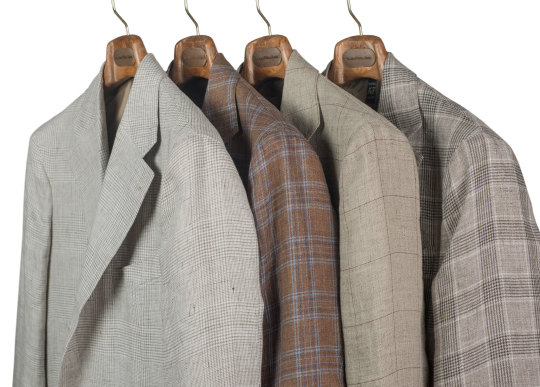
Third Summer Sport Coat: Something in Cream
When shopping for sport coats, it’s always safer to buy things in darker colors. That’s because most men will feel more comfortable following a particular formula: a dark jacket paired with a light-colored shirt (often light blue or white), medium-colored trousers (grey or tan), and dark shoes (black or brown). When you buy a lighter-colored jacket, you have to be more thoughtful about how you combine shirts and trousers. This extra step means you may be discouraged from ever wearing your lighter-colored jackets, relying instead on a familiar formula.
But summer outfits often benefit from having lighter colors. So for your third or fourth purchase, consider something in beige or cream. This can range anywhere from buttermilk (cream with just a touch of yellow) to oatmeal (beige with a grey cast).
These colors naturally make an outfit feel summery. They are cheerful without being bold and add diversity to a sport coat wardrobe that relies on darker colors. Yet, they don’t take that much coordination to wear. There are two tricks to finding trousers for lighter-colored jackets. The first is to try them with medium or dark grey pants, which almost always works. The other is to take the base color in your jacket and go a few shades lighter or darker for the pants. You can wear a beige sport coat with either off-white or medium brown trousers. Doing so allows you to strike some harmony, as the two pieces share the same color family. At the same time, there’s enough contrast between your jacket and pants that you don’t look like you’re wearing a weirdly mismatched suit.
Photos: Atelier BRIO, The Armoury, Gus Walbolt, and No Man Walks Alone
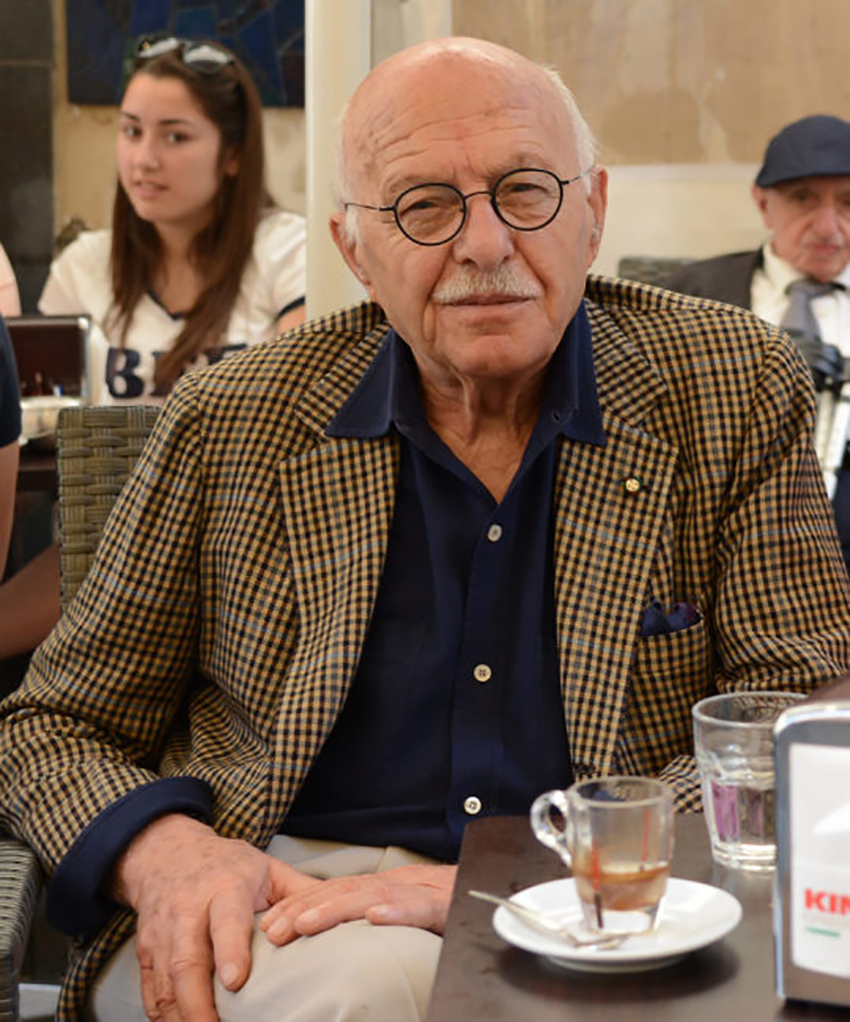

Shoulder Season Sport Coat: Faux Tweed
You’ll never hear the term “faux tweed” from a fabric merchant or tailor, but people who visit menswear forums and tailoring blogs occasionally use it to describe a particular kind of fabric. These are worsted fabrics that are smooth but not silky and carry the colors and patterns many people associate with traditional tweeds. They are citified versions of country cloths.
Faux tweeds are useful in the shoulder season, such as early spring and mid-fall, when the weather isn’t cold enough for a traditional tweed, but you might want to wear something with that sensibility. They look great with everything from tropical wool to whipcord trousers. The downside is that they can feel like neither fish nor fowl. Their smoother texture and small-scale patterns can make them feel like they sit halfway between proper jacketings and suitings. (Small scale patterns are typically better for suits, whereas sport coats often benefit from having larger patterns to distinguish them from orphaned suit jackets). Additionally, if the colors are too bright and cheery, they don’t feel right in mid-autumn. If they are too somber, they don’t feel right in late spring.
Yet, these can be a good way to incorporate a pattern into a springtime outfit. Even though clear-finished worsted patterns tend to be sharp and vivid, faux tweeds feel familiar and safe because they’re reminiscent of the tweeds you may already have in your wardrobe. Ones with “toothy” checks will feel more British because they look like the gun clubs associated with Scottish estates. Italian patterns tend to look more like complicated ginghams (i.e., the check is smoother and doesn’t have the toothy corner of the British variety). Consider getting one of these if you like district checks and want something to wear around shoulder season.
Photos: The Armoury and Sid Mashburn
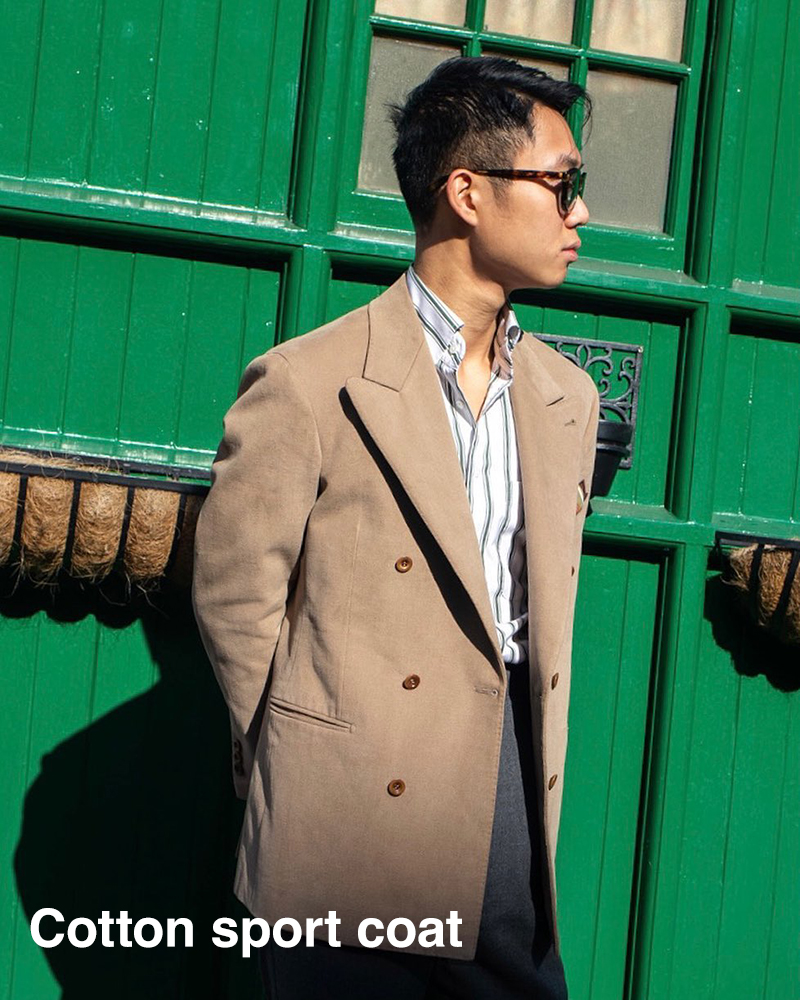
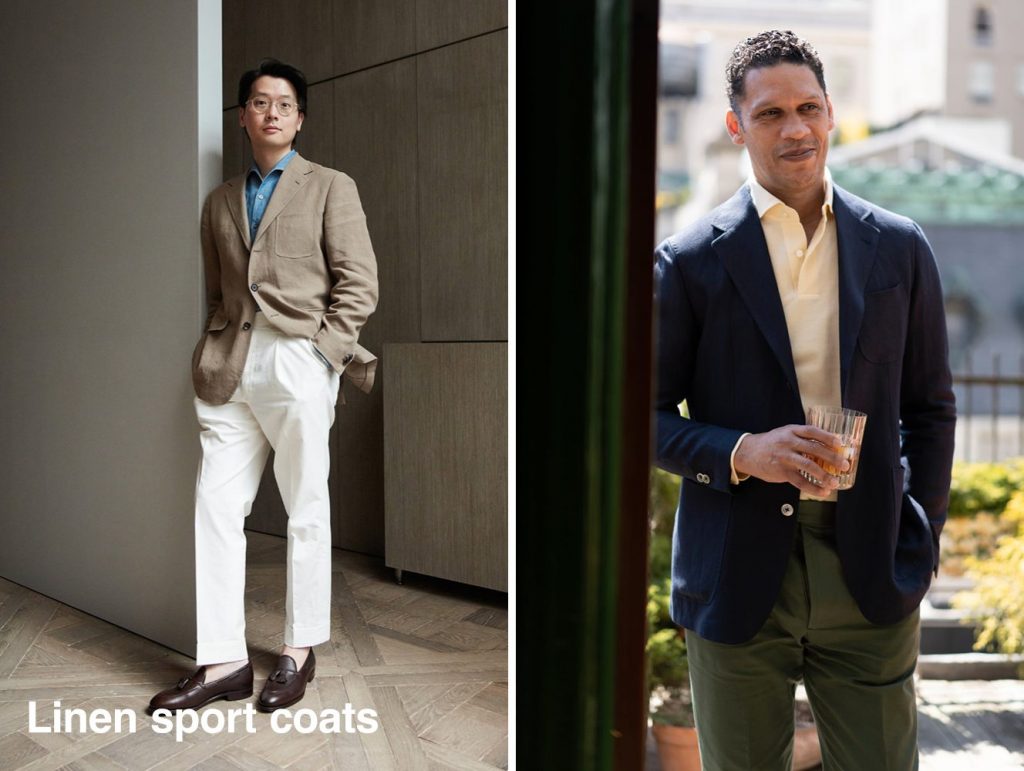
The Most Casual Sport Coat: Cotton and Linen
Cotton and linen are almost synonymous with summer. In spring/summer style guides, these fibers are often described as the most comfortable fibers you can wear in the heat. But the reality is a little more complicated. Since cotton is usually woven in a denser weave, such as drill, it can wear warmer than tropical wool. Both fibers also lack the crimp found in animal hair, so they feel stiff. If you put your hands into a wool jacket’s hip pockets, the material will feel springy. By contrast, cotton and linen don’t have any natural stretch unless they’ve been mixed with elastane. When getting a cotton or linen sport coat, button the coat and move your arms forward like you’re hugging someone. You want something that fits full enough to allow for comfortable movement. Otherwise, when you’re sitting at a table with your arms forward, the center back seam can feel like it’s about to rip.
There are other downsides to consider. Both materials age differently than wool; cotton fades in a patchy way, and linen develops a sheen.* When shopping for a cotton linen sport coat, consider lighter colors such as tan or stone, which will hide their age better over time than dark colors such as navy. You will also want to leave a little room when hemming. Since both fibers hold wrinkles, sleeves and legs will accordion with wear. If you get things hemmed just right in the beginning, they will be too short after a few months. This can be difficult to fix since cotton fades in places where it has been folded over, such as sleeve cuffs, and will show holes where there were once seams, making it difficult to let out the material.
Still, there’s something very charming about these jackets. If you’re worried about looking overly dressed up, no form of tailoring is more casual. Their rumply nature communicates the carefree attitude associated with summer. Get these made from midweight fabrics (between 12 and 14 ounces), so they rumple more than they wrinkle. Lightweight fabrics at or below 10 ounces will wrinkle like tissue paper, which can look charming in a shirt but less so in a jacket.

The main challenge is coordinating the different textures in your outfit. Sometimes a rumpled sport coat looks right with smooth wool trousers, and sometimes it doesn’t. It’s hard to pin this down to a rule, but the best way to figure this out is to practice with different combinations and develop an eye for what looks right. Some possible solutions: try wearing cotton or linen sport coats with tropical wool trousers. The crispness of tropical wool will complement linen better than fuzzy woolens such as flannel. You can also try denim (such as in the photo directly above). Mark Cho, the co-founder of The Armoury, is a big fan of his cream-colored linen sport coat. “Funnily enough, I find linen sport coats are easier to wear in cream,” he says. “Since cream is already such an unusual color, I don’t worry about the mismatch of the rumpled texture of linen with the smoothness of wool trousers. Whereas, if I was wearing a navy linen sport coat with gray wool trousers, I might pause for a bit.”
Personally, I find cotton sport coats to be easier to wear than pure linen, although I’ve been eyeing the patterns at Maison Hellard, a newly launched French linen company. Some of their fabrics have soft, subtle patterns reminiscent of easy-to-wear woolens. Many look like they would make for handsome sport coats.
* Pro-tip: if you have bespoke garments made and use dark linen, consider asking the tailor to use the reverse side of the cloth, rather than the face side. The face side of dark linen can sometimes have a heavy sheen, whereas if you reverse the fabric, it can be a little more matte.
Photos: The Anthology, The Armoury, and P. Johnson Tailors
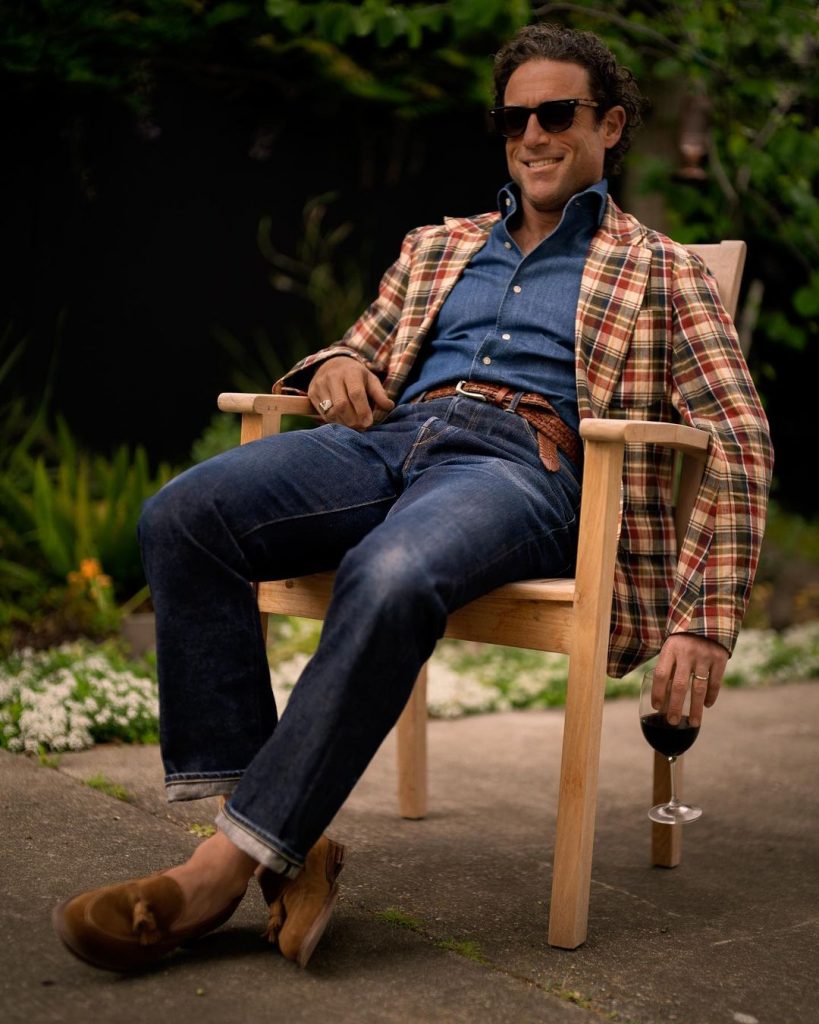

The Preppy Sport Coat: Madras, Seersucker, and Boating Blazers
If the options above are too conservative for you, consider the preppy clothes once made for the gainfully unemployed. Ivy league students, Old Money millionaires, and the otherwise privileged have worn extravagant, expressive things with their sedate trousers, paving the way for a style that’s simultaneously wild and classic.
There are three options here. The first is regatta striped rowing blazers, which our sponsor Jack Carlson, founder of the brand Rowing Blazers, has written about in a book. Rowing club members and spectators once wore these unusually striped blazers at sporting events. Over time, like navy blazers and rep striped ties, which used to be signifiers of belonging, they are now just worn for aesthetic reasons. In a strange way, since they don’t pair with anything, they go with everything. In the YouTube video above, Mark Cho of The Armoury shows how you can wear one of his company’s rowing blazers (now sold out) with everything from tan chinos to light blue trousers to jeans.
You can also try seersucker, the puckered, milk-and-sugar striped fabric that’s synonymous with Southern style. I think seersucker works best as a suit, but you can also wear seersucker jackets with tan chinos and white button-downs (black knit ties look strangely good with seersucker jackets). Lastly, for something relatively easy to wear, try madras. These designs hail from India, where locals once reinterpreted Scottish tartans using vegetable dyes and the colors traditional to their communities. Historically, madras tended to bleed, but the modern versions are almost always colorfast. They typically have riotous colors that scream summer and look best on bright afternoons and Sundays.
Photos: Peter Zottolo, Sartorial Notes, and Rowing Blazers
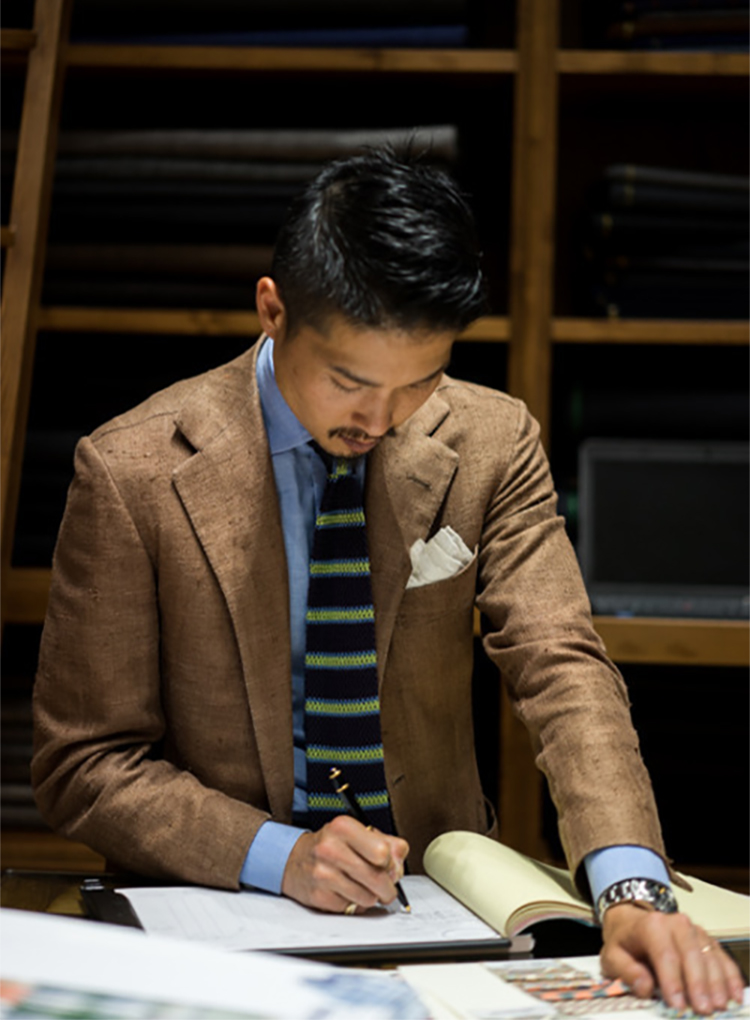
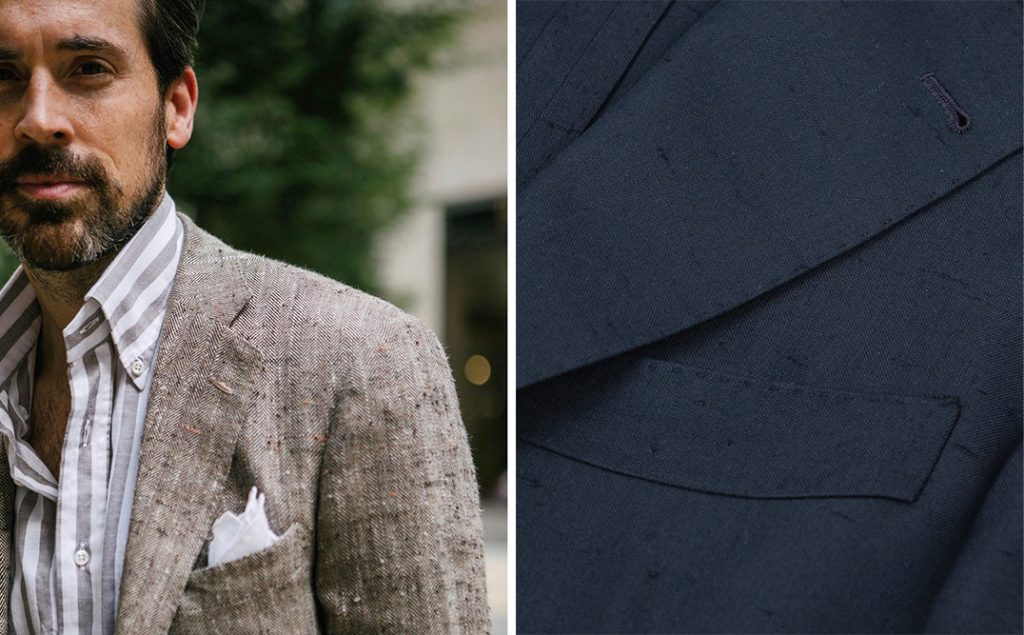
The Hobbyist Sport Coat: Raw Silk
Tailoring used to be a much more diverse field a generation ago. Back when it was more common for men to wear suits and sport coats, stores stocked clothes in everything from slippery wool gabardine to hardwearing Thornproofs. Today, much of that inventory has been reduced to four-season suits and a couple of Harris Tweeds.
Raw silk is one of those fabrics that used to be more common in men’s tailoring but has since all but disappeared. In the past, the stuff has been worn by Elvis, Jack Lemmon, Roger Moore, Mick Jagger, and Tennesse Williams. You may have seen it in the film Godfather II, where Michael Corleone wore an elephant-gray silk suit made with black and white flecks. From the film, you can see why raw silk was among the first things stores dropped. They are often, although not always, a bit shimmery. Depending on their weight and weave, they can wear a little warm in the summer, despite only being appropriate in summer. The flecks and slubs are also a little unusual and, in today’s world, might be mistaken for pulls and snags.
For tailoring hobbyists, however, a raw silk suit or sport coat can be a nice addition to a wardrobe already full of basics. Their unique texture lends visual interest to plainer summer outfits, and the fabric come in a range of weaves and finishes, including Matka, tussah, and dupioni. But good luck finding something. It’s difficult to find raw silk fabrics suitable for men’s tailoring (this includes getting something in the right weight and finish). Besnard briefly offered a navy dupioni coat (now sold out). Clients of custom tailors can also check fabric merchants such as Holland & Sherry and Ariston. Alan Flusser Custom shop owner Jonathan Sigmon has a sport coat made from one of Ariston’s silk-linen blends, and while it’s not technically raw silk, it has a similarly slubby texture.
Photos: Liverano & Liverano, Alan Flusser, and Besnard







